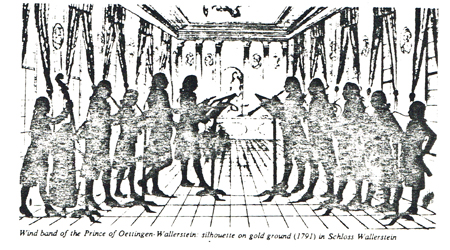
in the early 1980's


![]()
PURPOSE
The Circle Wind Octet was conceived by Richard Budick and Bob Zeilinger in August, 1982 as a means of presenting to the Bay Area the fine repertoire for wind octet, In addition, the group encourages new compositions for this medium by performing the works of Mr., Budick and others, The octet's first concert on November 14, 1982 was well received by an enthusiastic audience. An equally successful concert followed on April 17, 1983,
Our aim now is to reach a wider audience, people who have never heard
this delightful music and who are unlikely to go to a chamber music concert featuring it, Therefore, in the tradition of the Viennese octets which first performed these works, we intend to present a number of open-air concerts in public places throughout the Bay Area.
BIOGRAPHIES
Richard Burdick, horn, is a recent alumnus of the Youg People's Symphony Orchestra. He is curently involved in his composition, his Circle Concerts series, and freelancing with many Bay Area orchestras,
Bill Godbout, oboe, teaches music in the East Bay while continuing studies at San Francisco State University. His past associations include the Cape Ann Symphony, the New Hampshire Philharmonic, the San Francisco Children's Opera Orchestra and the San Francisco Chamber Orchestra.
Dick Palm, bassoon, is currently a member of the San Francisco Chamber Players and the Horizon Wind Quintet, He is a former member of the Berkeley Symphony Orchestra, and earlier, the Harvard-Radcliffe Orchestra, the Charles River Chamber Players, the M, I. T, Chamber Players and the Boston Summer Opera Theater,
Keith Sklower, oboe, plays for the California Bach Society, the Alameda
Mozart Festival Orchestra, the Prometheus Orchestra and the Trinity Chamber Orchestra, the last two as principal, He has also performed with the Symphony of the Mountain, the University of California Orchestra and L'Orchestra du Postes, Téléphones, et Télégraphe,Paris,
Jeff Sloan, bassoon, has performed in the past with the San Jose Symphony, the San Jose Opera Orchestra, the San Jose University Quintet and the Orchestra of the Conservatory of Santa Cecilia in Rome, He currently is a member of the Tobrini Wind Quintet.
Tom Winter, horn, has played principal with the Napa Symphony, the Diablo Symphony and the Fremont Symphony, He has also performed with the Berkeley Symphony Orchestra, the Vallejo Symphony, the Oakland Ballet Orchestra and the Pacific Philharmonic,
Bob Zeilinger, clarinet, is a member of the Trinity Chamber Orchestra and Concerto A Cinque, a woodwind quintet. He also plays principal in the Berkeley Symphonic Band.
HISTORY
The golden age of wind music dates from roughly 1760 to 1830, It was the fashion among the Viennese aristocracy to employ wind bands ("Harmonien") to provide music for many court occasions ranging from dinner music ("Tafelmusik") to serious concerts to lighter entertainment to even military and ceremonial music, The size of the bands varied from as few as two musicians to thirteen or more, but the standard combination consisted of pairs of horns an bassoons
with either oboes or clarinets or both, Flutes, English horns and basset horns were also occasionally used an one or two brass instruments would be added for military music, In imitation of the cout bands there were street bands of itinerant musicians.
The demand for music for these groups was enormous, Many courts had their own composers to provide original works and to make transcriptions of the popular operas, ballets, and symphonies of the day, Much of their work survives in the libaries of Euope, some of it published in modern editions, There are original works for wind octet by Haydn, Mozart, Beethoven, Schubert and their lesser-known contemporaries: Hummel, Krommer, Rosetti, Druschetzky, and others.
Among the transcriptions are Mozart's Abduction from the Seraglio, la Clemenza di Tito, Qosi Fan Tutte, Don Giovanni, The Marriage of Figaro and The Magic Flute as well as Beethoven's Fidelio, Still in manuscript are many operas by Rossini, Bellini and Donizetti an many more works,
But with the 19th century came the decline of the wind bands, Many of the nobility could no longer afford patronage and most of the groups were disbanded by 1800, though Prince Liechtenstein's survived until the 1830's, Attention turned from wind instruments to the violin and the piano and virtually no Romantic music was written for wind octet, Mendelssohn composed a student piece for eleven winds which he later rewrote as the Ouvertfire ffir Harmoniemusik, Op, 24 (1824) for 23 winds and percussion, But it wasn't until 1878 that Antonin Dvorak wrote the Serenade ig Q minor, Op, #4, for ten wind instruments, 'cello, and double-bass, And in 1879 the French flutist Paul Taffanel founded
the ”Société de Musique de Chambre pou Instruments a Vent," for which Charles Gounod composed his Petite Symphonie for nine wind instruments.
Twentieth century composers have begun to take renewed interest in the wind octet, encouraged by such groups as the Netherlands Wind Ensemble, Modern octets have been composed by Alfred Uhl, Gordon Jacob, Eugene Bozza, Bernhard Krol, Ezra Laderman, and others.

